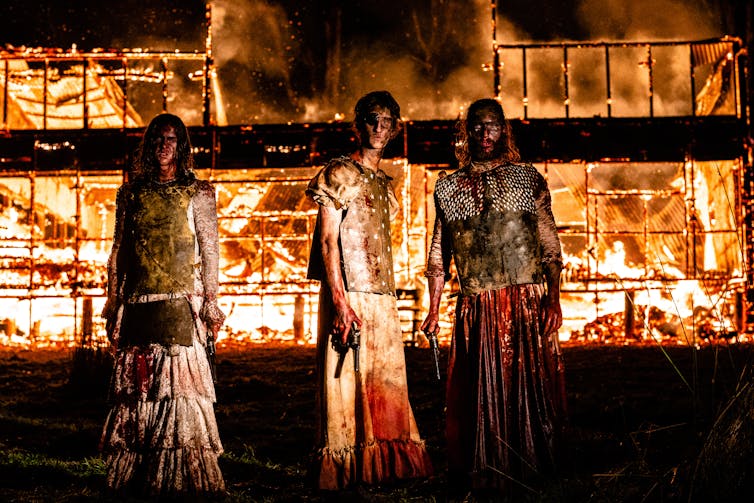Elena Volkova
The Anti-Blasphemy Message of the Feminist Punk-Prayer
Koshchunnitsy - a female plural form for a blasphemer - is a new word coined in Russia by a church official, arch priest Vsevolod Chaplin, while condemning Pussy Riot! But what was seen as blasphemy by ecclesial authorities was in fact an anti-blasphemy message addressed to clergy, lay people, and Russian society. having accused Pussy Riot of blasphemy, Russian Orthodox Church provoked a blasphemy counter discourse developed in this paper.

RELATED PAPERS
TRANSLATION: "The Pussy Riot Case and the Peculiarities of Russian Post-Secularism"
April L French
Download

Introduction to the Special Issue on Pussy Riot's Punk Prayer - Religion & Gender
Heleen Zorgdrager
Download

‘Black Robe, Golden Epaulettes’: From the Russian Dissidents to Pussy Riot, Religion and Gender, Vol 4, No 2 (2014), p.166-183.
Cécile Vaissié
Download

Pussy Riot and the Holy Foolishness of Punk
Kerith Woodyard
Download

Pussy Riot, the Media and Church-State Relations in Russia Today
Katja Richters
Download

An Inadvertent Sacrifice: Body Politics and Sovereign Power in the Pussy Riot Affair
Anya Bernstein
Download

Blasphemy Cries over Pussy Riot's "Punk Prayer"
Tore Lind
Download

Uzlaner, D. (2014) "The Pussy Riot Case and the Peculiarities of Russian Post-Secularism", State, Religion and Church 1(1): 23-58.
Dmitry Uzlaner
Download

“An Appeal to Mary: An Analysis of Pussy Riot’s Punk Performance in Moscow”
Nicholas Denysenko
Download

Chapter 2. On methodology. Why Pussy Riot?
Irina Talanova
Download

Lost in Translation? Pussy Riot Solidarity Activism and the Danger of Perpetuating North/Western Hegemonies
Masha Neufeld
Download

Sacrilege or Revelation? Pussy Riot in Russian Orthodox Culture
Dasha Filippova
Download

THE PUSSY RIOT CASE IN RUSSIA: ORTHODOX CANON LAW AND THE SENTENCE OF THE SECULAR COURT
Alexander PONOMARIOV
Download

"Women on the Fault Lines of Faith: Pussy Riot and the Insider/Outsider Challenge to Post-Soviet Orthodoxy"
Vera Shevzov
Download

Who is Pussy and Why is She Rioting
Choi Chatterjee
Download

Pussy Riot: Reflection on Receptions. Some Questions Concerning Public Reaction in Russia to the Pussy Riot’s Intervention and Trial
Yulia Gradsko
Download

Publicizing Pussy Riot: Translating (Inter) (Trans)National Memories on the Global Memoryscape
Nicole T . Allen, PhD
Download

Pussy Riot: Political Affect and Religious Feelings
Vasilina А Orlova (Василина Орлова)
Download

Pussy Riot and the Translatability of Cultures
Irina Dzero
Download

Triggering Political Affect: Generating Identities
Vasilina А Orlova (Василина Орлова)
Download

Blasphemy as Tool for Institutional Critique
Dasha Filippova
Download

ORTHODOX CHRISTIANS, SENSIBILITIES, AND OFFENDERS: A CASE STUDY OF YOUNG ORTHODOX BELIEVERS IN RUSSIA
Mariana Markova
Download

Like a Prayer: The Dissensual Aesthetics of Pussy Riot
Janus C Currie
Download

Don't Believe, Don't Be Afraid, Don't Ask: Pussy Riot, The Russian Orthodox Church, and the Soviet Shadow
Emily Durell
Download


Introduction to the Special Issue on Pussy Riot's Punk Prayer - Religion & Gender
Heleen Zorgdrager
Download

‘Black Robe, Golden Epaulettes’: From the Russian Dissidents to Pussy Riot, Religion and Gender, Vol 4, No 2 (2014), p.166-183.
Cécile Vaissié
Download

Pussy Riot and the Holy Foolishness of Punk
Kerith Woodyard
Download

Pussy Riot, the Media and Church-State Relations in Russia Today
Katja Richters
Download

An Inadvertent Sacrifice: Body Politics and Sovereign Power in the Pussy Riot Affair
Anya Bernstein
Download

Blasphemy Cries over Pussy Riot's "Punk Prayer"
Tore Lind
Download

Uzlaner, D. (2014) "The Pussy Riot Case and the Peculiarities of Russian Post-Secularism", State, Religion and Church 1(1): 23-58.
Dmitry Uzlaner
Download

“An Appeal to Mary: An Analysis of Pussy Riot’s Punk Performance in Moscow”
Nicholas Denysenko
Download

Chapter 2. On methodology. Why Pussy Riot?
Irina Talanova
Download

Lost in Translation? Pussy Riot Solidarity Activism and the Danger of Perpetuating North/Western Hegemonies
Masha Neufeld
Download

Sacrilege or Revelation? Pussy Riot in Russian Orthodox Culture
Dasha Filippova
Download

THE PUSSY RIOT CASE IN RUSSIA: ORTHODOX CANON LAW AND THE SENTENCE OF THE SECULAR COURT
Alexander PONOMARIOV
Download

"Women on the Fault Lines of Faith: Pussy Riot and the Insider/Outsider Challenge to Post-Soviet Orthodoxy"
Vera Shevzov
Download

Who is Pussy and Why is She Rioting
Choi Chatterjee
Download

Pussy Riot: Reflection on Receptions. Some Questions Concerning Public Reaction in Russia to the Pussy Riot’s Intervention and Trial
Yulia Gradsko
Download

Publicizing Pussy Riot: Translating (Inter) (Trans)National Memories on the Global Memoryscape
Nicole T . Allen, PhD
Download

Pussy Riot: Political Affect and Religious Feelings
Vasilina А Orlova (Василина Орлова)
Download

Pussy Riot and the Translatability of Cultures
Irina Dzero
Download

Triggering Political Affect: Generating Identities
Vasilina А Orlova (Василина Орлова)
Download

Blasphemy as Tool for Institutional Critique
Dasha Filippova
Download

ORTHODOX CHRISTIANS, SENSIBILITIES, AND OFFENDERS: A CASE STUDY OF YOUNG ORTHODOX BELIEVERS IN RUSSIA
Mariana Markova
Download

Like a Prayer: The Dissensual Aesthetics of Pussy Riot
Janus C Currie
Download

Don't Believe, Don't Be Afraid, Don't Ask: Pussy Riot, The Russian Orthodox Church, and the Soviet Shadow
Emily Durell
Download






















